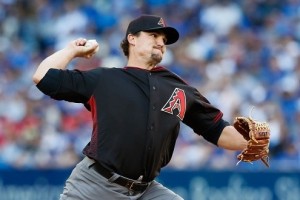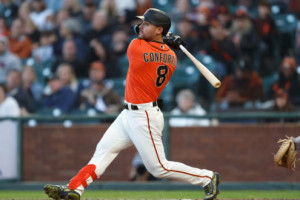10 Definitely Interesting, Possibly Helpful MLB Notes for July 27th
![]()
This MLB season, I’ll work to uncover some interesting bits of information that might shed some light on players from that day’s slate of MLB games. This is not a picks column, nor is it a “fun facts” article – it’s something in between.
I hope you enjoy it, and I hope it helps you think about today’s MLB plays in a new way as you build your DFS lineups. Here are 10 MLB notes for Thursday, July 27th.
1. Chris Archer has quality starts in 13 of his 15 career starts against the Yankees dating back to 2013, and he’s struck out six or more batters in eight of those games. Of the 16 pitchers with at least 10 starts against the Yankees since 2013, Archer leads them all in ERA (2.73), WHIP (0.958), batting average (.202), OBP (.259), and slugging (.320). Now, just to be clear, we should put little to no stock in Chris Archer dominating the Yankees three or four years ago. But it certainly doesn’t hurt that he hasn’t let the moment get to him in a matchup like this one. He’s got a stiff test against the 2017 version of the Yankees, who rank second in MLB in wOBA (.346) and wRC+ (116) and ninth in ISO (.191). Further, Archer gets a major park downgrade, and we all know about Archer’s drastic home/road splits (but just in case you don’t – since 2016, he’s got a 2.99 ERA at home and a 4.92 ERA on the road). For those reasons, he makes more sense for tournaments than cash games, even on a five-game slate. But make no mistake: he’s a strong tournament play. The Yankees have struck out 24.2% of the time against righties this month, fifth-most in MLB and just behind the Padres (24.4%), and Archer has ratcheted up his own strikeouts, with 8+ strikeouts in four straight games for the second time of his career. If he can limit the damage to even two or three earned runs, his upside is immense.
2. Here are the top ERAs in MLB since May 16th, in descending order:
Alex Wood (2.10)
Max Scherzer (1.91)
Clayton Kershaw (1.79)
??? (1.62)
Corey Kluber (1.52)
So, who’s the mystery player? It’s C.C. Sabathia, who is 7-1 over this most recent stretch with a respectable 22.0% strikeout rate, 51.8% ground balls, and just a 29.2% hard hit rate. And what’s more, based on Statcast data, it appears that Sabathia has earned his numbers and hasn’t skated by on luck: before May 16th, his expected wOBA (which takes exit velocity and launch angle into account) was .357, but from May 16th forward, his xwOBA is just .272, a figure on par with those posted by pitchers like Alex Wood (.270) and Jacob deGrom (.271). It’s a five-game slate, and the Rays strike out at a 26.0% clip against lefties (second-highest in MLB), so I suppose Sabathia is in play for tournaments. But more than anything, his recent success throws a bit of cold water on the the Tampa bats, especially when you consider that the Yankees now have arguably the most talented bullpen in MLB.

3. Zack Godley is one of seven pitchers this year with a 27.0%+ strikeout rate and a .244 wOBA or lower against right-handed batters. He’s in good company, as the other names on the list are Scherzer, Alex Wood, Kershaw, Carlos Martinez, Sale, and Kluber. Of those pitchers, only Wood (0.29) has a lower HR/9 to righties than Godley’s 0.39 mark, and only Scherzer (.228) and Wood (.233) have lower slugging percentages allowed to righties than Godley (.292). Even though the 5.7% HR/FB rate he’s carrying against righties will come up at some point, he’s been excellent at racking up strikeouts and limiting the damage to same-handed hitters. That should come in handy in his matchup against the Cardinals, who, with Dexter Fowler back on the DL, will be forced to roll out a lineup with seven, or possibly eight, right-handed hitters.
4. But even when Godley does run into the few lefties St. Louis has to offer (Matt Carpenter, Kolten Wong, possibly Greg Garcia), he’ll be fine. His 63.6% ground ball rate to lefties is third-best in baseball (min. 30 IP), and his -5.6 ° average launch angle to lefties is second-best, traiing only Dallas Keuchel (-8.7 °). His 83.2 mph average exit velocity against southpaws ranks 13th in MLB, which looks even better when you consider that the 12 pitchers ahead of him are all lefties themselves. So if he can handle righties, and he can handle lefties, that adds up to a pretty solid overall play. He’s my favorite SP2 to pair with your choice of Archer or Jon Lester in cash games.
5. It’s time for a game of blind resume! Take a look at the table below, which shows some DFS-relevant numbers for two mystery teams. Full disclosure, though – “Team A” represents the full-season numbers for one team, while “Team B” represents only that team’s numbers when they’re on the road (which is why Team A has so many more plate appearances):
| Stat | Team A | Team B |
|---|---|---|
| PA | 3,700 | 1,810 |
| wOBA | .299 | .301 |
| ISO | .165 | .156 |
| K% | 25.5% | 24.4% |
| wRC+ | 84 | 81 |
These two teams look very similar, for all intents and purposes. Team A has hit for slightly more power, but that coincides with a slightly higher tendency to strikeout. Despite the high K rate, Team A has been a smidge better, at least in terms of park-adjusted weighted runs-created plus.
Team A is the San Diego Padres. Team B is the Arizona Diamondbacks on the road. When Arizona plays outside of Chase Field, their numbers become strikingly pedestrian (Padrestrian? No…sorry about that), and on Thursday, they’re on the road against the Cardinals highly touted Luke Weaver. Weaver has been starting in the minors – where dominated, posting a 1.91 ERA and 0.94 WHIP for AAA Memphis – so pitch count shouldn’t be a major issue (though you’ll certainly want to monitor Twitter for any updates). If he’s all systems go, he’s a super interesting as a cheap SP2 option given the D-backs struggles away from home.
6. Since 2015, only two batters in MLB (min. 800 PA) have a .250+ ISO and a sub-15.0% strikeout rate against righties: David Ortiz and Anthony Rizzo. Rizzo’s combination of power and low strikeouts is rare, and against Mike Pelfrey, who has just a 6.4% swinging strike rate this year against all batters and a 14.6% strikeout rate against lefties, he’s sure to make solid contact. Even further, if we look into Pelfrey’s pitch repertoire, we see that his primary pitch against lefties is his sinker, which he throws 54.75% of the time this year. The sinker is a pitch Rizzo has crushed over the past few years; since 2015, he has a .350 ISO against the pitch, fifth-best in MLB (min. 100 AB) and trailing only Matt Carpenter, Miguel Cabrera, Nelson Cruz, and Bryce Harper. Rizzo is one of the top overall plays (if the the top overall play) on the main slate.

7. This year, Michael Conforto has a .535 xwOBA against two-seam fastballs, the third-best mark in MLB (min. 25 AB ending in the two-seamer), and his .575 ISO against the pitch rank second in all of baseball. His opponent on the mound on Thursday, San Diego’s Luis Perdomo, is right-handed, and he throws a two-seam fastball more than any other pitch to left-handed batters. Perdomo is a pitcher we typically don’t want to attack, mainly because of his insane ground ball numbers. But it’s worth noting that while the 59.9% ground balls Perdomo induces to righties is high, it’s nothing compared to the 70.2% he induces to righties (a figure which leads all of MLB by almost five percentage points). Lefties, on the other hand, have had success against him (.379 wOBA this year), and Conforto’s success against the two-seamer makes him an excellent tournament play, even in PetCo Park.
8. If the above note on Conforto was a little too granular (I’ll admit – the sample is very small), here’s a simpler note to illustrate how dominant he’s been with the platoon advantage this year: his .429 wOBA and .312 ISO against right-handed pitching is matched by only two players in MLB. Those players are Bryce Harper and Aaron Judge.
9. After homering last night, Paul DeJong now has home runs in 14 of his first 49 games in MLB. Only one other Cardinals player in history can say he homered 14 times in his first 49 games as a big leaguer: Albert Pujols. DeJong has a difficult matchup against the aforementioned Zack Godley, but he’s cheap, he’s got power, and he’s got multi-position eligibility; that combination isn’t easy to come by on a five-game slate. DeJong homered against quality pitchers like Jon Lester, Jacob deGrom, Jose Quintana, Aaron Nola, and Jon Gray. And while picking on Zack Godley isn’t something we’d prefer to do, it is worth noting that his fly ball rate is much more manageable for right-handed hitters (32.1% vs. RHB, 14.8% vs. LHB) and that he sees an uptick in hard contact against righties, as well (31.6% vs. RHB, 26.6% vs. LHB).
10. Take a look at Christian Yelich’s OPS marks by month this season:
April – .746
May – .736
June – .744
July – 1.033
Now, let’s look at Yelich’s average launch angle by month:
April – 4.1 °
May – 2.3 °
June – 3.1 °
July – 8.2 °
Yelich’s increase in OPS (and ISO, as his .234 mark in July also represents a season-high) has corresponded with an increased launch angle. Who knows if this is a real change or if it’s just the variance that happens over the course of the season? Either way, Yelich homered again last night (or at least I think he homered – when the Fish score 22 runs and Dee Gordon homers, I assume that just means everyone gets a homer), which makes two straight games with home runs. He’s still hitting plenty of balls into the ground, which puts a cap on his upside, but his 53.3% ground ball rate this month is his lowest of any calendar month this year. Plus, he’s been making better contact lately, with nine barrels in July (the previous season-high for any month this year was five). On this five-game slate, hitting is tough, and Yelich is an affordable bat in a plus matchup. On this slate, that’s enough to make him a worthy cash game target.
_____________________________________________________________________________________________________________________________________________________________
Thanks for reading! Stats from this article were pulled from RotoGrinders’ Daily Research Console, FanGraphs, Baseball Savant, and Baseball Reference.
Check back for more “10 Notes” MLB articles throughout the year, and feel free to drop a comment below if you want to leave any feedback or keep the discussion going!
Follow Josh Cole on Twitter, where I post interesting stats whenever I dig them up!